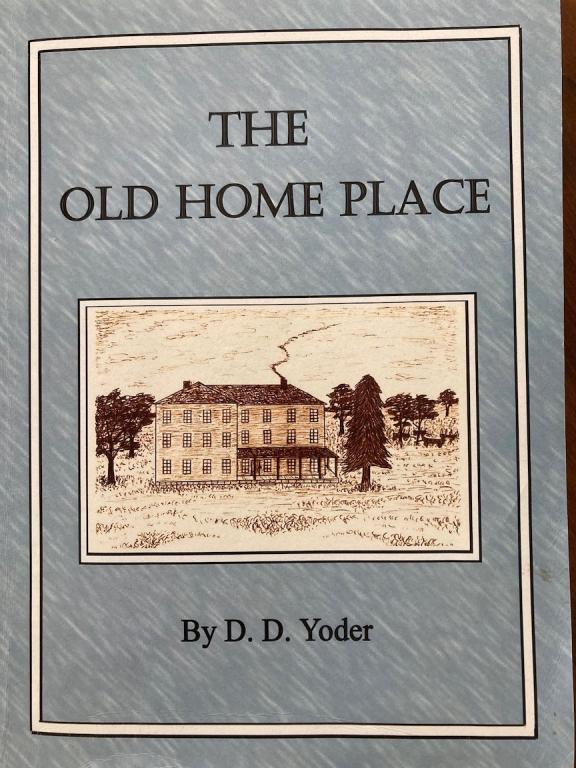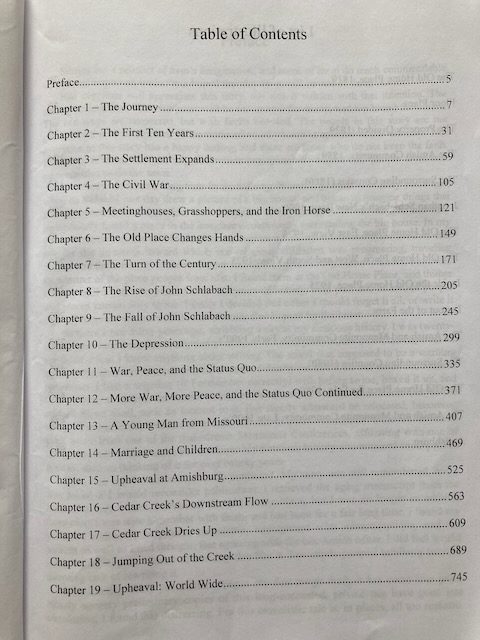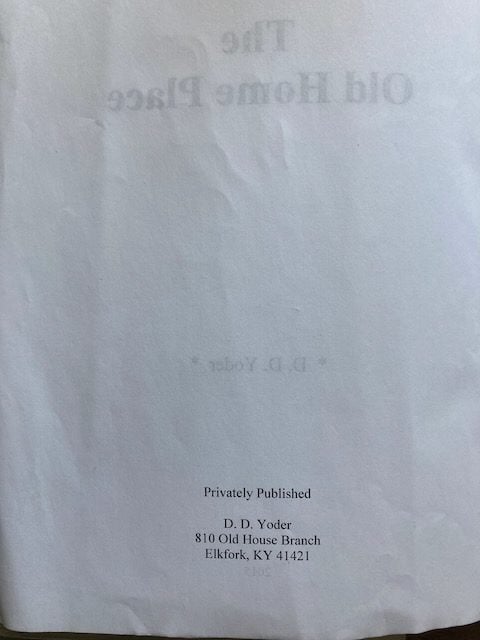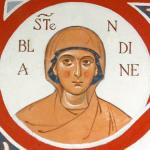You might be tempted to imagine the Amish as a quaint homespun people untroubled by modernity, a people without original thoughts who walk in lockstep with the bishop. The Old Home Place, a work of historical fiction, will disabuse you of any those notions.
This nearly-800-page novel tells the story of a single Amish-Mennonite house (and its surrounding community) located somewhere in the American Midwest. That may not seem like a compelling premise, but this book is both a doorstopper and a page-turner. Consider the following narrative twists:
- A Civil War shootout in the living room
- An epidemic of bundling, a method of courtship in which a young man sneaks into a young woman’s bedroom and lies next to her fully clothed as they hold a conversation
- A wife wakes up to find her husband lying dead beside her. Since it’s her only chance to get a photograph of him (photography is still discouraged, and church authorities will soon need to be notified), she changes him from his nightgown to his Sunday hook-and-eye shirt, his broadfall trousers, and frock coat. She pushes his mouth shut, drags him by the armpits down the stairs, and props him up against the side of the house for a picture.
- Lively controversies over whether shirts should be fastened using copper buttons (the traditional custom) or using hooks and eyes (the worldly method)
- An apostate Mennonite shoots at the Amish bishop when he shows up to visit.
- An epidemic of folk medicine (or evil magic?) called powwowing
 The James Michener-style epic begins with settlement in 1819. Levi Miller and his brother John clear the land of trees and build an enormous structure that houses the five original settler families. The socially isolated community then negotiates the rise of new technology (from rubber wheels in the nineteenth century to the Internet in the twenty-first century), cultural tension caused by rumspringa, and theological innovation in the form of revivalism. The author, Dale Yoder, is at his best depicting how disquieting it was for plain people to witness the arrival of the automobile and the television.
The James Michener-style epic begins with settlement in 1819. Levi Miller and his brother John clear the land of trees and build an enormous structure that houses the five original settler families. The socially isolated community then negotiates the rise of new technology (from rubber wheels in the nineteenth century to the Internet in the twenty-first century), cultural tension caused by rumspringa, and theological innovation in the form of revivalism. The author, Dale Yoder, is at his best depicting how disquieting it was for plain people to witness the arrival of the automobile and the television.
Indeed, The Old Home Place is a very human book. Yoder describes rebellion, incest, child abuse, alcoholism, domineering preachers, miserliness, and mental illness. He captures the tedium of life. “The old home place,” he writes, “grew older, and Ami grew older . . . He kept sitting and waiting.” For death. Amish-Mennonites—like most Americans in the nineteenth century—died early and often from disease, violence, accidents, and bad medicine.
Yoder captures the significance of small differences. If you want to understand the theological and cultural idiosyncrasies of a mind-numbing number of Amish-Mennonite splinter groups, then this is your book. He makes plain people of all stripes intelligible to each other by explaining, always with precision and often tenderly, why raging debates over the dimensions and texture and colors of a headcovering (from hanging veils to microscopic doilies) mattered. He describes the negotiation of the ordnung, “a little book with all their rules in,” among the Horning, Holdeman, black bumper, conservative, Weaverland, Lancaster Conference, Eastern Pennsylvania Mennonite, Pilgrim, Midwest Fellowship, Mid-Atlantic Fellowship Mennonites, just to name a few. As one of his characters says, “So, people will be people, and even at Cedar Creek it at times took a bit of grace to get along.”
But residents of the old home place sometimes did get along. Yoder nicely captures moments of beauty, remarkable acts of unselfishness and humility, and eras of churchly concord. Indeed, parts of the novel remind me of a scholarly article by Steve Nolt, eminent historian of the Amish, who once wrote, “Listening for the clash of ecclesial conflict or the squeaky wheel of tension and stress is often a useful way of locating the essence of religious movements, but so too are the quieter sounds of harmony.” Church life certainly involves the clanging of cymbals, but it also involves wind chimes. There is story after story in The Old Home Place of people working things out. Like this one:
The districts to the west were not quite as strict, but order was kept, and when the youth met to sing, that is what they did. The Amishburg District and its new East District were yet more lenient, for where variations develop between districts, there will of necessity be those which are most lenient. But the differences were not so great that Jacob Brandenburger did not occasionally preach at Amishburg, and sometimes Bishop Solomon Byler would point his buggy toward the south, and he was always received down there. Solomon grew up to become a much-respected bishop, who maintained the ordnung they had. But he also preached Christ, and His death and resurrection and the Life that He bestows, including the practical out workings of that life.
 Another virtue of The Old Home Place is the way it depicts Amish intersections with major events and trends in American history. Amish and Mennonites, while ensconced in their own subculture, have not been completely insulated from the rise of leisure, the conflagration of the Civil War, the economic panic of 1893, harassment by patriotic neighbors during the Great War, the Great Depression, the hippie movement, and the Vietnam War. Yoder’s description of the rise of Amish tourism in the late-twentieth century is particularly apt:
Another virtue of The Old Home Place is the way it depicts Amish intersections with major events and trends in American history. Amish and Mennonites, while ensconced in their own subculture, have not been completely insulated from the rise of leisure, the conflagration of the Civil War, the economic panic of 1893, harassment by patriotic neighbors during the Great War, the Great Depression, the hippie movement, and the Vietnam War. Yoder’s description of the rise of Amish tourism in the late-twentieth century is particularly apt:
One day an oversized RV arrived carrying an upper middle-aged couple from the urban end of some far away suburb. They entered the store looking for Amish cheese and bologna but found mostly regular groceries and hardware. The man bought a plastic container of Mountain Dew and sat outside on a bench talking to a local Amish passerby, asking him how much the government pays him for being Amish, and whether he gets paid vacations. The plump lady, with her white knee britches and baggy red top, waddled down the street snapping pictures, and then she entered the school. Suddenly everyone inside heard, “Ooh, ain’t they cute!” and the flashbulb started flashing.
So is the Amish-Mennonite encounter with American Protestant fundamentalism, narrated by Yoder in the form of a young couple’s honeymoon:
They didn’t go to California. The Appalachians held enough sights for them. They saw Old Smokey, Cumberland Falls, a natural bridge in Kentucky, and on the way home, the Creation Museum. Then they returned to Caroline’s old home, packed her possessions and a few of the wedding presents, and the last leg of the journey was made in two vehicles, Daniel in the old black Oldsmobile, and Caroline in her little silver Toyota Camry.
I’ve never been to the Creation Museum or the Ark to see for myself, but I hear that Amish and conservative Mennonites regularly flood Ken Ham’s amusement parks and keep them afloat.
The novel is direct. As you might expect from a conservative Mennonite of Swiss-German extraction, Yoder has written a taut and workmanlike book. It’s not overwrought, and he gets his points across.
The novel does have limits. It could offer a bit more empathy toward moderate and liberal Mennonites. They come off looking terribly at the end. But liberals who practice tolerance and openness have many practitioners and interpreters these days. It’s good to see a novel that makes plain communities more intelligible.
More problematic is the ending. This work of historical fiction doesn’t end in 2000—or even 2023. With too many echoes of Left Behind (although if I’m reading it right, The Old Home Place is post-tribulation premillennial, not pre-trib.) for my theological taste, it reaches into the future with premillennial doom:
For he was a religious man, and he recognized the direction the world was headed, and he knew the Yoders would lead those precious souls, delivered to their care, in the direction of eternal safety. The world was not a safe place. The future looked dark. Apprehension was continually increasing for those who feared God.
There is a martyr/persecution complex:
Daniel and Caroline faithfully taught them at home. But this was becoming illegal also. The world said that children should be eighteen before they hear of religion, so they can analyze it objectively, and choose what they want for themselves, hopefully rejecting it, as they were taught to do in the public schools. For religion causes hate, so they said, and the world would be better off without it. Yes, there were a lot of people by this time that hated religion, or at least the True Religion.
There is end-times apocalypse in which God owns the libs. Jerusalem and its secular Jews are blown away. A new world government in Geneva governs from the cathedral where John Calvin used to preach. A Frenchman named Voltaire II is the World Premier. An eighteen-digit number (6 x 6 x 6) embedded in each person’s chip. Washington, D.C., is ultimately destroyed, and the lesbian president is “blown to eternity” in an act of “God’s judgment.”
And finally, rapture:
Then one morning at the Old Home Place, after a hearty breakfast of bacon and eggs, with toast and butter and jelly, the household rose from their places, and were about to tend to their daily affairs. Suddenly there was a bit of a rattle, and a sort of an odd noise off to the west. “What was that?” asked Bishop Daniel, his beard now speckled with gray.
“I don’t know, it felt a little like a tremor,” answered Caroline, her hair also streaked with gray. They shrugged their shoulders and were about to go on their way. Then they heard another voice. It sounded like a horn blowing, or a trumpet.
Suddenly in the twinkling of an eye, they vanished. Yes! That Great Day had finally come, as God had promised—in an hour when they thought not. They were gone. Or most of them were. For their children had been obedient, and they were accepting that Saving Faith, or most of them were. The Old Home Place was suddenly empty, except for one teen aged boy. He’d just turned seventeen. He had been there, some years before, during those dark and terrible days. Back when he believed that there might be something to this religion of his caretakers. But everything had straightened out. He was no longer so sure of this narrow religion. He was making secret plans to leave, to attend college, and make something of himself. The world looked alluring. There were a lot of things out there of which he was being deprived. . . . Where had everyone gone? And what was that noise? He ran through the house, calling people’s names. They were not there. Not a single soul. . . . He looked below. Far below he saw the hard sidewalk. Without hesitation he jumped. But he did not escape, for the Trump continued to sound, now in a tone more terrible, and all the rest of the dead came forth. . . . Now the Old Home Place was empty. Its years were accomplished. Its usefulness was fulfilled. Suddenly everything was destroyed. THE END.
 The past (and apparently, the present and future too) is a foreign country. They do things differently there.
The past (and apparently, the present and future too) is a foreign country. They do things differently there.
Intrigued enough to get your own copy? You should—it’s a fascinating and lovely and disturbing book, and it made me think hard about how to pass on faith and tradition to my children. But you’ll have to work at finding a copy. It’s not available on Amazon. In fact, it’s nowhere online. Self-published and self-printed in an obscure Eastern Kentucky holler, you have to send $20 by post to the author himself. If you’re lucky like me, you might even get a kind handwritten letter tucked into the pages of the book.













